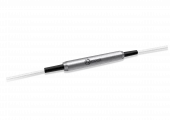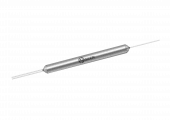Description
Fused couplers are used to split optical signals between two (or more) fibers or to combine optical signals from two (or more) fibers into one fiber. They are constructed by fusing and tapering the fibers together. This method creates a simple, rugged, compact method of splitting or combining optical signals. Typical excess losses are as low as 0.2 dB, while split ratio tolerances range from ±5% to ±0.5% at design wavelengths depending upon the splitting ratio. These devices are bidirectional and offer low backreflection and insertion losses.
Polarization Maintaining Fused Fiber Couplers and Splitters
Specifications
| Wavelength Range: | 780 - 2005 nm |
|---|---|
| Directivity: | 55 dB |
| Bandwidth: | ±1.25 % of center wavelength, ±20 nm |
| Return Loss: | <50 dB |
| Directivity: | <55 dB |
| Operating Temperature: | 0°C to 70°C |
| Storage Temperature: | -40°C to 85°C |
Features
- Low loss and cost
- Broad bandwidth
- Good uniformity
- Small package
- High directivity
- Wide variety of wavelengths 780 nm–2005 nm
Applications
- Optical amplifiers
- Fiber lasers
- Power monitoring
- Fiber gyroscopes
- Coherent communications
Frequently Asked Questions
What are the features of these devices?
The features include low loss and cost, broad bandwidth, good uniformity, small package, high directivity, and a wide variety of wavelengths from 780 nm–2005 nm.
What are Polarization Maintaining Fused Fiber Couplers and Splitters used for?
They are used to split optical signals between two (or more) fibers or to combine optical signals from two (or more) fibers into one fiber.
What are some applications of these devices?
Some applications include optical amplifiers, fiber lasers, power monitoring, fiber gyroscopes, and coherent communications.
What is the range of split ratio tolerances at design wavelengths?
The split ratio tolerances range from ±5% to ±0.5% at design wavelengths depending upon the splitting ratio.
What is the typical excess loss of these devices?
Typical excess losses are as low as 0.2 dB.
Similar Products

1310 Standard Y-Waveguide
Shanghai Aoshi Control Technology Co.Ltd

LN15-22CFH Lithium Niobate Integrated Optical Multi-Function Chip Y-Waveguide
Shanghai Aoshi Control Technology Co.Ltd

Ascentta Tunable 1x2 Optical Coupler (1270, 1310, 1450, 1550, 1650nm)
Ascentta

Polarization Maintaining Filter Coupler-PMFC
GKER Photonics

Polarization Maintaining Tap Coupler-PMTC
GKER Photonics

980 -1060 nm Singlemode Coupler
GKER Photonics

Multimode Fiber Filter Coupler-MMFC
GKER Photonics

Singlemode Broadband Coupler (GK-SBC Series)
GKER Photonics

488 - 2100 nm Polarization Maintaining Fused Coupler-PMC
GKER Photonics

Singlemode Broadband Coupler 850 -1310nm
GKER Photonics

Polarization Maintaining Tap Coupler
GKER Photonics

1550nm Ultra Low Ratio Tap Coupler GK-LTC Series
GKER Photonics
Thank You!
Your inquiry has been received.
Create an account by adding a password
Why create an account?
- Auto-complete inquiry forms
- View and manage all your past messages
- Save products to your favorites
- Close your account anytime — no hassle

